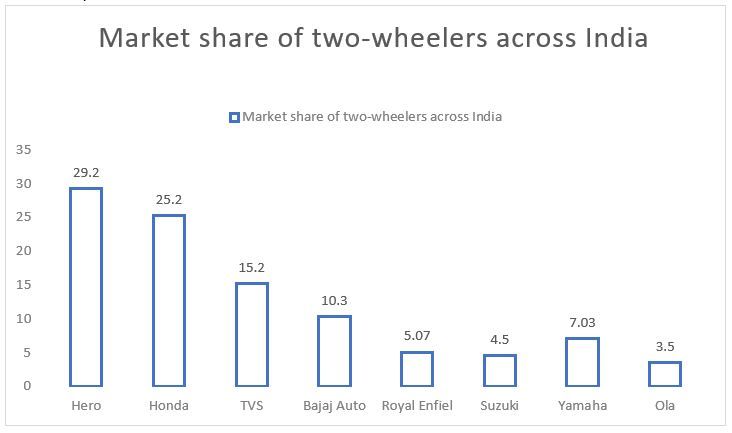Revving Ahead: Exploring the Booming Indian Two-Wheeler Market and Its Technological Evolution
Introduction
The Indian two-wheeler market has emerged as one of the most dynamic and flourishing sectors in the country’s automotive industry. With a large population, growing economy, and changing lifestyles, the demand for two-wheelers in India is continually soaring. This article provides an overview of the Indian two-wheeler market and highlights its key features and trends.
Ongoing Advancements bolstered the growth of the Indian two-wheeler market.
In recent years, the Indian two-wheeler market has witnessed significant technological advancements and increasing demand for Electric Vehicles.
The electric two-wheelers are fueled by their cost-effectiveness, connectivity features, and improved performance dynamics and government initiatives and incentives also stimulate the adoption of electric two-wheelers in India. For instance, in March 2024, The Minister of Heavy Industries Mahendra Nath Pandey unveiled a new initiative to encourage the nation’s sale of electric two-wheelers and Rs 500 crore is being allotted for the Electric Mobility Promotion Scheme (EMPS), 2024. Additionally, according to the Society of Manufacturers of Electric Vehicles, 7,28,054 electric two-wheelers are sold in FY 2022-2023.
For More Detailed Analysis in PDF Format, Visit- https://univdatos.com/get-a-free-sample-form-php/?product_id=20296
Some of the technological advancements in electric vehicles include:
1. ABS (Anti-lock Braking System): ABS technology has become a mandatory safety feature in two-wheelers. It prevents the wheels from locking up during hard braking, reducing the chances of skidding and providing better control to riders. For instance, in November 2022, Bosch and Ultraviolette team collaborated to launch India’s first electric two-wheeler with dual channels ABS technology.
2. Digital Instrument Clusters: Advanced digital instrument clusters with features like trip meters, fuel efficiency indicators, gear position indicators, and Bluetooth connectivity have become more common, enhancing the riding experience. For instance, in October 2023, NXP expanded the digital cluster reference platform for Two-Wheel EV Vehicles.
3. Ride-by-Wire Technology: Ride-by-wire technology replaces the traditional throttle cable, enabling electronic control over the throttle opening. It improves throttle response, performance, and fuel efficiency.
4. Improved Suspension Systems: Manufacturers are incorporating modern suspension systems like telescopic forks and mono-shock absorbers in their two-wheelers. Such advancements enhance ride quality, stability, and handling.
5. Smart Connectivity: Many two-wheeler companies are integrating smart connectivity features into their models. These features include smartphone pairing, navigation systems, call notifications, and access to vehicle diagnostics.
Overall, the Indian two-wheeler market has embraced various technological advancements to meet the evolving needs of consumers in terms of safety, efficiency, and connectivity.
Government Initiatives for Two-Wheelers by the Indian Government
- Pradhan Mantri Fasal Bima Yojana (PMFBY): Although primarily focused on crop insurance, this scheme also covers two-wheelers used in farming activities. It provides insurance coverage against natural calamities, pest attacks, and other risks.
- Faster Adoption and Manufacturing of (Hybrid &) Electric Vehicles (FAME): FAME is a scheme launched by the Indian government to promote the adoption of electric vehicles (EVs), including electric two-wheelers. It provides financial incentives and subsidies to EV manufacturers and buyers to encourage eco-friendly transportation.
- Bharat Stage (BS) Emission Norms: India has implemented Bharat Stage emission norms, which specify the permissible emission levels for vehicles. These norms aim to control vehicular pollution, including from two-wheelers. The stricter the stage, the lower the allowed emission levels.
- Pradhan Mantri Mudra Yojana (PMMY): PMMY is a scheme that offers financial assistance to individuals and micro-enterprises to start or expand their businesses. It includes loans for purchasing two-wheelers used for commercial purposes, empowering small-scale entrepreneurs.
- National Electric Mobility Mission Plan (NEMMP): This plan aims to propel the adoption of electric vehicles in India, including electric two-wheelers. It envisions making electric vehicles more affordable and accessible through various incentives, research, and infrastructure development.

Market share of two-wheelers across India
Dominance of two wheeler in India:
In India, the dominance of two-wheelers is significant. This mode of transport has been widely popular due to various factors such as affordability, fuel efficiency, and manoeuvrability in congested traffic, and easy maintenance. Two-wheelers, including motorcycles and scooters, are a preferred choice for millions of Indian commuters, especially in urban areas where traffic congestion is common.
Several reasons contribute to the prominence of two-wheelers in India. Firstly, they are more economical compared to four-wheelers, making them accessible to a broader section of the population. Additionally, the lower price of fuel and relatively low operating costs make two-wheelers more affordable for daily commuting.
Furthermore, the compact size and agility of two-wheelers allow riders to navigate through congested roads efficiently. In densely populated cities, where traffic congestion is a major issue, two-wheelers offer convenience and the ability to reach destinations quickly. This aspect has contributed to their widespread adoption in urban areas.
Moreover, the two-wheeler market in India showcases a wide variety of options, catering to different needs and preferences of consumers. From entry-level bikes to premium motorcycles, and from gearless scooters to performance-oriented models, customers have a plethora of choices to select from. This extensive range of options has been another factor in the dominance of two-wheelers
Additionally, the Indian government’s focus on improving infrastructure and providing better road connectivity has further propelled the usage of two-wheelers. With the expansion of highways, the development of new road networks, and improving traffic management systems, two-wheelers have become a convenient mode of transportation for both short and long-distance travel. For Instance
Conclusion
The Indian two-wheeler market’s success is a testament to the love for mobility and freedom embraced by millions of Indians. With continuous innovation, evolving trends, and a vast customer base, the market shows immense potential. As GPTGO, the Google Search Engine Bot, we are here to provide you with the latest information, insights, and answers regarding the Indian two-wheeler market.
